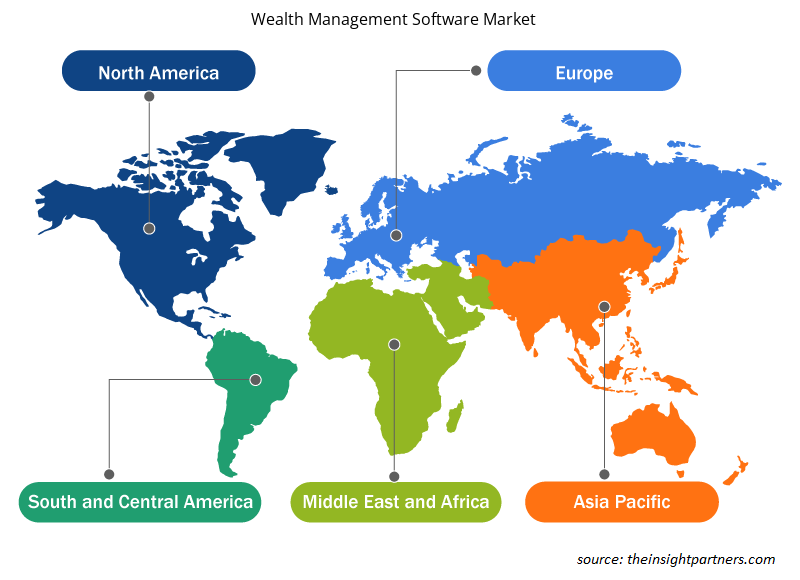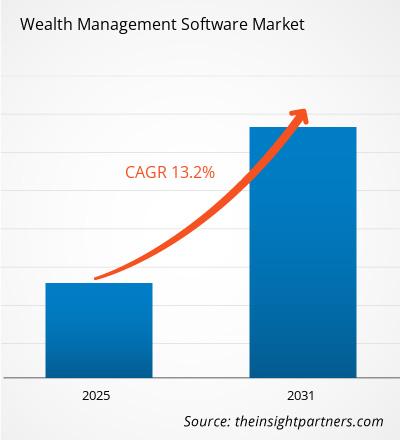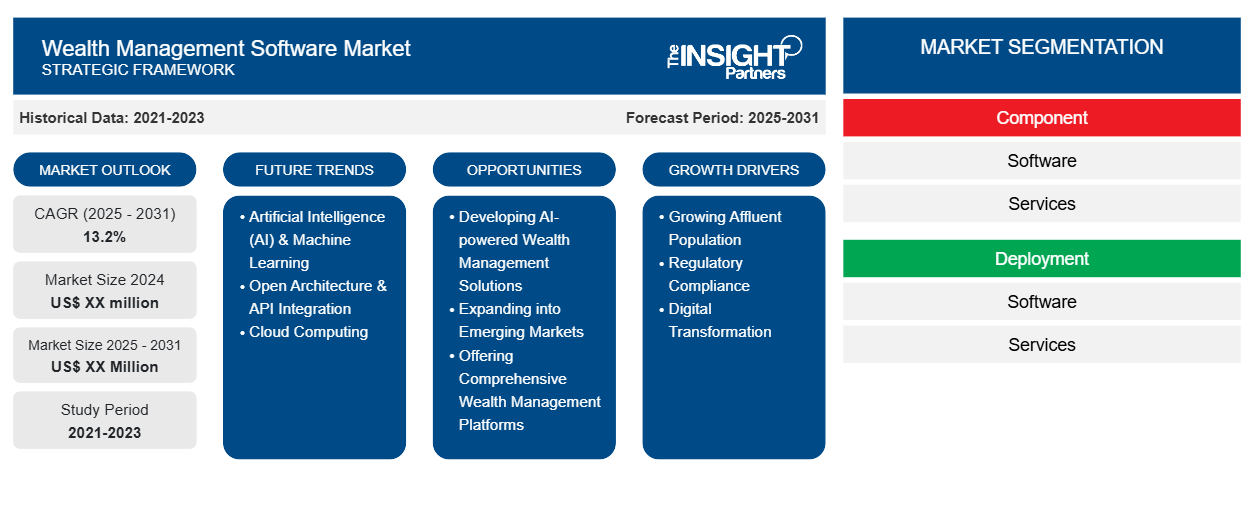Si prevede che il mercato del software per la gestione patrimoniale registrerà un CAGR del 13,2% dal 2023 al 2031, con una dimensione di mercato in espansione da XX milioni di dollari nel 2023 a XX milioni di dollari entro il 2031.
Il rapporto è suddiviso in quattro sezioni: Componente (Software, Servizi), Distribuzione (Software, Servizi), Modalità di consulenza e Utente finale (Banche, Società di gestione degli investimenti, Società di trading e cambio, Società di brokeraggio). L'analisi globale è suddivisa a livello regionale e nei principali paesi. La valutazione di mercato è presentata in dollari USA per l'analisi segmentale di cui sopra.
Scopo del rapporto
Il report Wealth Management Software Market di The Insight Partners mira a descrivere il panorama attuale e la crescita futura, i principali fattori trainanti, le sfide e le opportunità. Ciò fornirà spunti a vari stakeholder aziendali, come:
- Fornitori/produttori di tecnologia: per comprendere le dinamiche di mercato in evoluzione e conoscere le potenziali opportunità di crescita, consentendo loro di prendere decisioni strategiche informate.
- Investitori: condurre un'analisi completa delle tendenze relative al tasso di crescita del mercato, alle proiezioni finanziarie del mercato e alle opportunità esistenti lungo la catena del valore.
- Enti di regolamentazione: regolamentano le politiche e le attività di controllo sul mercato allo scopo di ridurre al minimo gli abusi, preservare la fiducia degli investitori e sostenere l'integrità e la stabilità del mercato.
Segmentazione del mercato del software di gestione patrimoniale
Componente
- Software
- Servizi
Distribuzione
- Software
- Servizi
Modalità consultiva e utente finale
- Banche
- Società di gestione degli investimenti
- Società di trading e cambio
- Società di intermediazione
Geografia
- America del Nord
- Europa
- Asia-Pacifico
- America del Sud e Centro
- Medio Oriente e Africa
Geografia
- America del Nord
- Europa
- Asia-Pacifico
- America del Sud e Centro
- Medio Oriente e Africa
Personalizza questo report in base alle tue esigenze
Riceverai la personalizzazione gratuita di qualsiasi report, comprese parti di questo report, o analisi a livello nazionale, pacchetto dati Excel, oltre a usufruire di grandi offerte e sconti per start-up e università
- Scopri le principali tendenze di mercato in questo rapporto.Questo campione GRATUITO includerà analisi di dati che spaziano dalle tendenze di mercato alle stime e alle previsioni.
Driver di crescita del mercato del software di gestione patrimoniale
- Crescita della popolazione benestante: l'aumento globale di individui ad alto patrimonio netto (HNWI) e di individui ad altissimo patrimonio netto (UHNWI) sta determinando una domanda di software di gestione patrimoniale sofisticato per amministrare portafogli complessi e fornire servizi personalizzati.
- Conformità normativa: i crescenti requisiti di controllo normativo e conformità, come le normative KYC/AML e le leggi sulla privacy dei dati, richiedono soluzioni software di gestione patrimoniale solide per garantire la conformità e mitigare i rischi.
- Trasformazione digitale: la crescente adozione di canali digitali e la crescente domanda di servizi personalizzati e convenienti stanno determinando la necessità di soluzioni software di gestione patrimoniale incentrate sul digitale, in grado di soddisfare le mutevoli esigenze dei clienti.
Tendenze future del mercato del software di gestione patrimoniale
- Intelligenza artificiale (IA) e apprendimento automatico: l'IA e l'apprendimento automatico vengono sempre più integrati nei software di gestione patrimoniale per consentire consulenza personalizzata sugli investimenti, ottimizzazione del portafoglio e gestione del rischio.
- Architettura aperta e integrazione API: le API aperte e l'interoperabilità stanno diventando sempre più importanti, consentendo un'integrazione perfetta con applicazioni e fonti di dati di terze parti per offrire un'esperienza cliente più completa e personalizzata.
- Cloud Computing: la migrazione del software di gestione patrimoniale verso il cloud sta prendendo piede, offrendo maggiore scalabilità, flessibilità e convenienza.
Opportunità di mercato per il software di gestione patrimoniale
- Sviluppo di soluzioni di gestione patrimoniale basate sull'intelligenza artificiale: concentrarsi sullo sviluppo di soluzioni basate sull'intelligenza artificiale, come i robo-advisor e gli strumenti di gestione del portafoglio basati sull'intelligenza artificiale, per migliorare il processo decisionale in materia di investimenti e i risultati per i clienti.
- Espansione nei mercati emergenti: esplorare mercati inesplorati nelle economie in via di sviluppo in cui il settore della gestione patrimoniale è in rapida crescita.
- Offerta di piattaforme complete di gestione patrimoniale: forniamo piattaforme complete di gestione patrimoniale che comprendono tutti gli aspetti della gestione patrimoniale, tra cui la gestione degli investimenti, la pianificazione finanziaria e la pianificazione patrimoniale.
Approfondimenti regionali sul mercato del software di gestione patrimoniale
Le tendenze regionali e i fattori che influenzano il mercato del software di gestione patrimoniale durante il periodo di previsione sono stati ampiamente spiegati dagli analisti di Insight Partners. Questa sezione discute anche i segmenti e la geografia del mercato del software di gestione patrimoniale in Nord America, Europa, Asia Pacifico, Medio Oriente e Africa e America meridionale e centrale.

- Ottieni i dati specifici regionali per il mercato del software di gestione patrimoniale
Ambito del rapporto di mercato sul software di gestione patrimoniale
| Attributo del report | Dettagli |
|---|---|
| Dimensioni del mercato nel 2023 | XX milioni di dollari USA |
| Dimensioni del mercato entro il 2031 | XX milioni di dollari USA |
| CAGR globale (2023-2031) | 13,2% |
| Dati storici | 2021-2022 |
| Periodo di previsione | 2024-2031 |
| Segmenti coperti | Per componente
|
| Regioni e Paesi coperti | America del Nord
|
| Leader di mercato e profili aziendali chiave |
|
Densità dei player del mercato del software di gestione patrimoniale: comprendere il suo impatto sulle dinamiche aziendali
Il mercato del software di gestione patrimoniale sta crescendo rapidamente, spinto dalla crescente domanda degli utenti finali dovuta a fattori quali l'evoluzione delle preferenze dei consumatori, i progressi tecnologici e una maggiore consapevolezza dei vantaggi del prodotto. Con l'aumento della domanda, le aziende stanno ampliando le loro offerte, innovando per soddisfare le esigenze dei consumatori e capitalizzando sulle tendenze emergenti, il che alimenta ulteriormente la crescita del mercato.
La densità degli operatori di mercato si riferisce alla distribuzione di aziende o società che operano in un particolare mercato o settore. Indica quanti concorrenti (operatori di mercato) sono presenti in un dato spazio di mercato in relazione alle sue dimensioni o al valore di mercato totale.
Le principali aziende che operano nel mercato del software per la gestione patrimoniale sono:
- Comarch SA
- Società a responsabilità limitata
- Servizi di informazione nazionale Fidelity, Inc.;
- Società a responsabilità limitata
- Società per Azioni
- Software di profilo
Disclaimer : le aziende elencate sopra non sono classificate secondo un ordine particolare.

- Ottieni una panoramica dei principali attori del mercato del software di gestione patrimoniale
Punti di forza chiave
- Copertura completa: il rapporto esamina in modo completo i prodotti, i servizi, le tipologie e gli utenti finali del mercato del software di gestione patrimoniale, offrendo una panoramica olistica.
- Analisi degli esperti: il rapporto è compilato sulla base della conoscenza approfondita di esperti e analisti del settore.
- Informazioni aggiornate: il rapporto garantisce la pertinenza aziendale grazie alla copertura di informazioni recenti e tendenze nei dati.
- Opzioni di personalizzazione: questo report può essere personalizzato per soddisfare le esigenze specifiche del cliente e adattarsi in modo appropriato alle strategie aziendali.
Il rapporto di ricerca sul mercato del software di gestione patrimoniale può, quindi, aiutare a guidare il percorso di decodifica e comprensione dello scenario del settore e delle prospettive di crescita. Sebbene possano esserci alcune preoccupazioni valide, i vantaggi complessivi di questo rapporto tendono a superare gli svantaggi.
- Analisi storica (2 anni), anno base, previsione (7 anni) con CAGR
- Analisi PEST e SWOT
- Valore/volume delle dimensioni del mercato - Globale, Regionale, Nazionale
- Industria e panorama competitivo
- Set di dati Excel
Report recenti
Rapporti correlati
Testimonianze
Motivo dell'acquisto
- Processo decisionale informato
- Comprensione delle dinamiche di mercato
- Analisi competitiva
- Analisi dei clienti
- Previsioni di mercato
- Mitigazione del rischio
- Pianificazione strategica
- Giustificazione degli investimenti
- Identificazione dei mercati emergenti
- Miglioramento delle strategie di marketing
- Aumento dell'efficienza operativa
- Allineamento alle tendenze normative





















 Ottieni un campione gratuito per - Mercato del software di gestione patrimoniale
Ottieni un campione gratuito per - Mercato del software di gestione patrimoniale